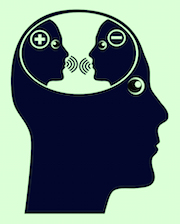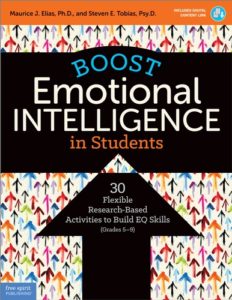Emotional Intelligence: Why Should We Teach It
Strong feelings – especially those related to stress – can interfere with clear thinking. Most adults know this from personal experience. Our students who are able to manage difficult emotions – who have sufficient emotional intelligence – will be better able to attend to the learning task at hand even in challenging personal circumstances.
Emotional intelligence (EQ) can be concisely defined as: The ability to manage one’s feelings and interact positively with other people.
This is the core of EQ. Yet emotional intelligence goes far beyond this snapshot. EQ involves both the emotional skills and the social skills necessary for happiness and success in school and life, and students who are not prepared with these skills will be at a serious disadvantage in their educational and career trajectories.
High EQ is tied to a positive sense of self, as well as to the ability to have meaningful and rewarding relationships with others. Like its partner and complement “IQ” (which is primarily about a person’s reasoning ability), EQ promotes academic achievement and helps students become more available for learning.
Additionally, emotional intelligence is more highly correlated with career success than are academic skills.
Most employers value responsible, hard-working employees who can handle stress, communicate clearly and assertively, act with integrity, find creative solutions to problems, anticipate and manage challenges, resolve conflicts, and get along with coworkers. Every one of these skills is an aspect of emotional intelligence.
Tweens and Teens Are Social Creatures
As human beings, we are social creatures – and this is especially true of pre-adolescents and adolescents. For your students, positive relationships (especially those with their peers) provide emotional support and help them feel more secure about themselves and their world, which in turn can enable them to challenge themselves and grow.
Furthermore, students who are good at solving social and emotional problems in keeping with their own values are likely to be more successful in all areas of life. This is what EQ is all about. Emotional intelligence is not optional or supplemental, but rather is an integral facet of education. The learning of these skills is a developmental right and an issue of social justice and equity.
Preparing students for the world of their adulthood—a global community requiring sophisticated understanding of oneself as well as of other people and their motives, perspectives, capabilities, and desires—is one of our most critical jobs as educators. EQ can help.
What Are the Essential EQ Skills?
If you’ve ever seen a newborn, you know that his or her first smile—usually at a parent—is a major milestone.That smile cements a bond between parent and child, and it’s an early example of the importance of relationship skills in all areas of life.
Nearly everything we do throughout our lives depends on our emotional intelligence, from maintaining healthy relationships to achieving our goals. So it’s essential to understand the components that make up this essential human competency.
EQ can be broken down into three main skill areas:
- Self-awareness and self-management: the ability to assess and know one’s own emotions, values, and capabilities (both strengths and weaknesses); the ability to cope with emotions and maintain self-control; the ability to persevere to achieve a goal.
- Social awareness and relationship skills: the ability to understand others and empathize with an awareness of individual and group similarities and differences; the ability to communicate effectively, both perceiving others’ messages and expressing oneself; the ability to work cooperatively with others.
- Responsible decision-making and problem-solving: the ability to establish positive goals; the ability to implement effective behaviors to achieve those goals; the ability to resolve interpersonal conflicts constructively.
Although these skills might seem like common sense, as Voltaire observed (and as most of us have seen for ourselves at one time or another),“common sense is not so common.” And because these skills are so important for students’ development and for their futures, we don’t want to take teaching them for granted.

These kids, and all our students, can benefit from further development of their EQ skills, which they will need when negotiating everyday challenges, large and small. Indeed, many of these skills may already be familiar to you from other contexts, such as drug abuse prevention and anti-bullying programs as well as character education curricula.
EQ Skills and the Adolescent Brain
The adolescent brain is notable for its advanced development in emotions without corresponding developmental advances in self-control.
During adolescence, the limbic system—a primitive area deep inside the brain that humans share with all mammals—is developing faster than the prefrontal cortex, which is responsible for judgment and self-control. The limbic system seeks stimulus, sometimes through risk-taking behaviors and other intense experiences, and is triggered by social and emotional stimuli.
It can feel good to the teen brain to have the limbic system stimulated by things such as horror movies, sexual experiences, social media interactions, recognition from peers, sports and competition, drugs, music, gossip, parties, video games, or even just good friends.
These experiences can provide quick and easy stimulation, but not all of them are safe. However, adolescents don’t always reflect on safety when they are seeking excitement.
This failure to evaluate risk or consider consequences has nothing to do with cognitive ability. Middle school students are just as capable of understanding things as adults are. Nevertheless, their capability for thoughtful decision-making can be overshadowed or overridden by their intense responses to social relationships and feelings.
So, given these biological and developmental realities, you may ask yourself whether it’s truly realistic to teach middle school students how to manage their emotions and use their best knowledge and judgment. Might it be more logical to wait for the prefrontal cortex to further develop, and hope for the best in the meantime?
In fact, this is the perfect time to teach kids emotional awareness and self-regulation. The brain is most malleable while it is growing and developing, which means that at this time in students’ lives, we have not only an opportunity but an obligation to promote self-understanding, self-control, and good choices.
Teaching adolescents to identify, name, and manage their feelings provides them with foundational skills for decision-making, problem-solving, and healthy interactions with others. The ability to cope with emotions—especially those that are challenging or complex—is an antidote to impulsive or reckless behavior and the key to a lifetime of strong and positive relationships.
Other Developmental Considerations
As you work to build emotional intelligence skills in your students, you will likely run into challenges, many connected to the fact that middle school is a time of dramatic development and flux for students’ independence and identities. At this stage of development, it is useful to keep in mind the following ideas and consider how to adapt your instruction accordingly.

Adolescents may also need help resolving conflicts with peers. Your students may find it more difficult to get along with others than in the past. They tend to have many minor fights and disputes with little awareness of the possible consequences. Teaching restorative strategies and assertive communication for conflict resolution will help kids manage these situations. When the need for discipline arises, it’s helpful to think in terms of learning and corrective opportunities. (Read “How EQ Instruction Supports Behavior Management.”)
Students view their world with greater sophistication than when they were younger and are able to be more aware of different perspectives and their own feelings. They are becoming more independent and complex in their thinking, while also becoming more susceptible to peer pressure. Because their sense of self is not yet fully formed, they often feel acutely self-conscious and self-critical and may react to their uncertainties about themselves by being critical of others or rejecting them.

You can download Lesson 7 here.
Adolescents are coping with rapid physical and hormonal changes, and with each passing year, they will be more aware of and interested in adult behaviors, including drug use, alcohol use, and sex. They will need to make healthy decisions for themselves regarding these behaviors within a context of social and familial values (many of which they will be questioning and evaluating). To do so, they need to develop their own values, as well as honing their skills in self-control.
Students are increasingly being asked to set personal goals and consider how to achieve them. This helps prepare them for college and careers, where they’ll have to manage their own time in goal-directed ways, but many students initially find these skills hard to master. They often need adults’ support, guidance, and limits.
Adolescents continue to require physical outlets. Their bodies and minds need physical exercise.They still need to go outside and play or at least to move around regularly. Yet aside from organized sports, many middle school students do not do this. Their academic and social activities are increasingly sedentary, but the adolescent brain benefits from physical activity, which provides stress relief and aids cognitive refocusing.
Outlets for personal creativity are important. Students need to be able to develop a sense of self and express their individual identities. That’s why extracurricular activities are so important in school. Sometimes nonacademic areas are students’ greatest outlets for creativity. Students need strategies more than scripts.
Adolescents accept rules better when they have had a voice in creating them. They need to feel heard and to have a sense of autonomy. In fact, students often surprise adults with the strictness of the rules they will recommend when these guidelines are developed collaboratively. Kids are consistently testing the limits set for them by adults. This is not defiance, but normal testing to see if the limits will hold and if authority figures will enforce them.
Membership and a sense of belonging in groups, especially groups of peers, are of paramount importance to adolescents. Being accepted by and belonging to a group affirms students’ individual identities and provides them with a much-needed sense of reassurance as they navigate these difficult years. This is one reason that troubled young people are often drawn to peers who face similar challenges or circumstances. It is important to encourage students to join extracurricular groups and activities.
Friends are tremendously meaningful to kids during these years, as they are growing much more peer-oriented than family-oriented at this stage. As part of this development, kids often need to learn how to select their friends deliberately and carefully. They also may need guidance in understanding that friendships are reciprocal, not only about pleasing others nor only about what they personally get from these relationships.
Kids are developing leadership skills as well as followership skills—learning how to take charge and also how to be a responsible and supportive member of a group. Adolescents have many opportunities to take leadership roles in formal and informal settings. As students participate in activities and discussions, be aware of group dynamics and intervene when necessary to reinforce active listening, respectful communication, and other social and emotional skills.
Make Students Your Partners
It’s essential to make students your partners as you work on EQ skills. Fill them in; give them details. It is important that students understand not only what these skills are, but also why they are so important to learn. When adolescents feel respected, recognized, and trusted, they are far more likely to buy in to what they’re learning.
_______________________







































